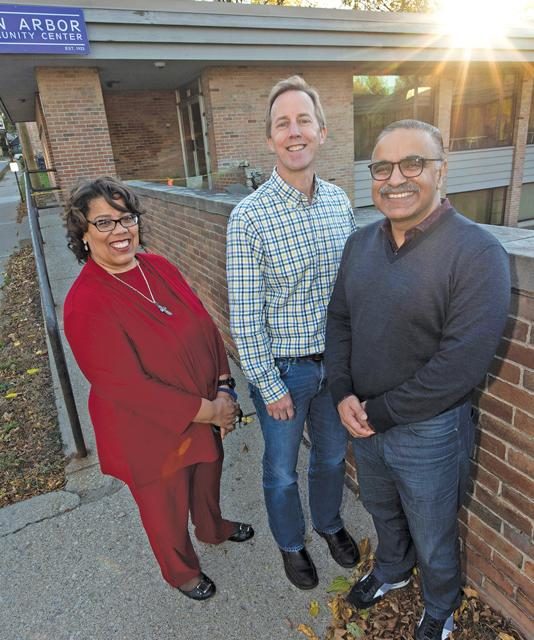Tucked into a hillside, with two levels looking over a recessed courtyard, the low brick building at 625 N. Main epitomizes architect Alden Dow’s “Michigan Modern” style. But until last year, it still had the original single-pane windows Dow had specified when it was built in 1958. Many had cracks, adding to the drafts—and the gas bill.
They needed to be replaced, but “we didn’t have funds to do it,” says Perry. So the native Ann Arborite and longtime AACC board member “put up plastic wrap on windows,” secured loose floor tiles, and otherwise tried to keep the building functioning. But he couldn’t do much about the leaky roof, because the struggling social service agency couldn’t afford to replace that, either. CEO Yolanda Whiten kept buckets handy.
So Perry and Whiten are delighted that the building now has new windows, a new roof, and upgraded plumbing and other systems. But many older black Ann Arborites do not share their pleasure. That’s because 625 N. Main also has a new owner.
Last November, the AACC sold its building to medical entrepreneur Vik Kheterpal for $1.6 million. His software company, CareEvolution, now occupies the upper level.
No announcement was made. Kheterpal left the AACC sign in place, and the agency continues to operate from the lower level. But when the news got out this summer, it was met with consternation.
At an October meeting at the center, speaker after speaker testified to how vital the AACC had been in its early years, when it was a social center for the largely black neighborhoods nearby. They questioned the need for the sale, the price paid, and the board’s failure to inform or consult them. First Ward councilmember Sumi Kailasapathy predicted the building would be “flipped” for a quick profit.
Board chair Mike Murphy acknowledged that other suiters wanted to tear the building down and replace it with a bigger one. To prevent that, he said, the center issued a request for proposals that required the buyer to preserve Dow’s building and keep the AACC in operation there.
Kheterpal says that’s exactly what will happen. Keeping the AACC in the building “is a commitment that we made,” he says. This is his second company—he sold the first to GE in 2000—and his wife, Bithika, is an ophthalmologist who’d previously volunteered at the AACC and served on its board. They’re fortunate to be at a stage of life, he says, where “we are not looking to accumulate further wealth.”
They also admired Dow’s design. “We got [the original] plans from the Dow archives … and that just further cemented the conviction—not just for the community’s interest, but our interest—in not having a big high-rise show up” on the site, he says.
He’s not even changing the contractors AACC uses or the local person Whiten has been working with for years who mows the grass and clears the sidewalk and parking lot when it snows. “This is not altruism,” Kheterpal says. “It just makes sense.”
Perry adds that the center no longer needed so much space. “The demographics have changed,” he says. Only a few of the original black families remain in the neighborhood, and few newcomers need the services—like emergency food and school supplies—that the AACC provides. They were able to expand those offerings this year, Whiten says, with money from the sale.
She gives an example. “I got a text yesterday from one of the coordinators in one of our schools—’We need socks and underwear,'” she says. So she went out and bought some, and made the delivery. “It helps the self esteem of a child,” she explains. “If you accidentally wet your pants because your family is upside down, you want a clean set of underwear.” And, she adds, “Where [else] can you get socks and underwear delivered to your school?”
“Without this agreement, I couldn’t have told you where the community center would be in one year, or two years,” Murphy told the October meeting. “Right now the money is being conservatively invested for the sustainability of the center, so we can have a community center for the public for years to come.”
The board set aside a year’s operating budget—about $200,000—and put the rest in a money market account while they investigate investment options. Whiten hopes it will eventually grow into a significant endowment.
Whiten, an ordained minister, also pastors a small AME church in Brighton. She says she understands how attached people can be to a building.
But the AACC’s mission, she says, is “not the building, it’s the people we serve.” Thanks to the sale, she says, that is “alive and well, and in better shape than it has ever been.”


